Samsung’s Galaxy S20 is a powerful 5G phone with the latest camera technology and a super-sharp Quad-HD+ display.
 If you’re looking for a high-end 5G-ready smartphone, one of your primary contenders at the moment should be Samsung’s Galaxy S20 series.
If you’re looking for a high-end 5G-ready smartphone, one of your primary contenders at the moment should be Samsung’s Galaxy S20 series.
The Galaxy S20 devices have cutting-edge cameras that allow you to take professional-looking photos at a resolution of up to 108 megapixels. You’ll also get a super-sharp Quad HD+ screen using Samsung’s trademark AMOLED technology for a rich and vibrant viewing experience. Samsung’s smartphones also lead the market with their support for 5G, with over half of all 5G smartphones last year being made by Samsung.
In this article, we’ll review and compare the handsets in the Samsung Galaxy S20 family including the Galaxy S20, the Galaxy S20+ and the Galaxy S20 Ultra. We’ll also look at key features of the handsets including the camera, display, network connectivity, design and software.
Contents
Which Galaxy S20?
Samsung’s latest flagship range of smartphones is the Galaxy S20 series, which consists of the Galaxy S20, the Galaxy S20+ and the Galaxy S20 Ultra.
The following table shows some of the key differences between the three phones:
| Samsung Galaxy S20 | Samsung Galaxy S20+ | Samsung Galaxy S20 Ultra |
|---|---|---|
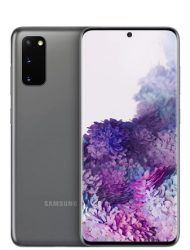 |
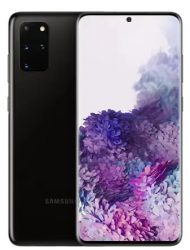 |
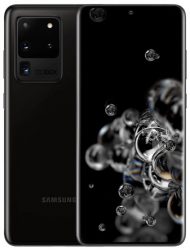 |
| Has a triple-camera system with optical image stabilisation. Up to 64 megapixel resolution photos and up to 8K-quality video. | Has a quad-camera system with optical image stabilisation and a depth vision camera. Up to 64 megapixels with 8K-quality video. | Has a quad-camera system with optical image stabilisation and a depth vision camera. Up to 108 megapixels with 8K-quality video. |
| Has a 6.2-inch AMOLED display with Quad HD+ resolution (3200×1400). | Has a 6.7-inch AMOLED display with Quad HD+ resolution (3200×1400). | Has a 6.9-inch AMOLED display with Quad HD+ resolution (3200×1400). |
| Available in both 4G & 5G versions. | Available with 5G connectivity. | Available with 5G connectivity. |
| Weighs 163g and has a 4,000mAh battery with fast charging. | Weighs 186g and has a 4,500mAh battery with fast charging. | Weighs 220g and has a 5,000mAh battery with fast charging. |
Through the rest of this article, we’ll take a more in-depth look at the features of the Galaxy S20 phones including the camera, display, network connectivity, design and software. We’ll also look at the technical specifications of each device.
Camera
 For many people, the camera on their mobile phone is now the primary way of capturing and recording special memories for the future. It’s an area where we see continued innovation, and it’s one of the key features that now really sets smartphones apart from each other.
For many people, the camera on their mobile phone is now the primary way of capturing and recording special memories for the future. It’s an area where we see continued innovation, and it’s one of the key features that now really sets smartphones apart from each other.
On the Samsung Galaxy S20, you’ll get three rear-facing cameras with optical image stabilisation (OIS) built-in to the system. There’s a 12-megapixel ultra-wide camera with a 123° field of view, a 12-megapixel wide-angle camera and a 64-megapixel telephoto camera. For improved low-light photography, the main camera has 1.8µm pixels (this compares to 1.4µm on other handsets like the iPhone 11). It means more light is able to reach the sensor for each individual pixel, giving clearer and brighter photos in low-light conditions. Meanwhile, the high-resolution telephoto sensor allows you to take highly detailed close-ups with 3x “hybrid optical” zoom and 30x “super resolution” zoom.
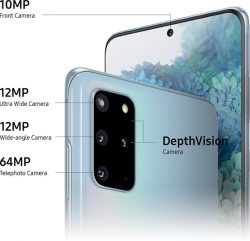 If you choose the Galaxy S20+ instead of the Galaxy S20, you’ll get an additional time-of-flight sensor (making a total of four rear-facing cameras). Known as the DepthVision camera, the additional sensor measures the distance to different objects in your image. It enables better portrait photography, with the “bokeh” depth-of-field effect which is often seen on photos from a professional SLR camera.
If you choose the Galaxy S20+ instead of the Galaxy S20, you’ll get an additional time-of-flight sensor (making a total of four rear-facing cameras). Known as the DepthVision camera, the additional sensor measures the distance to different objects in your image. It enables better portrait photography, with the “bokeh” depth-of-field effect which is often seen on photos from a professional SLR camera.
The Galaxy S20 Ultra has a further upgrade, with the wide-angle camera increasing up to 108 megapixels. This gives you the ability to go up to 10x hybrid optical zoom and 100x super resolution zoom. In most cases, however, you’ll probably still use it as a regular 12 megapixel camera to save on storage space. If you do this, Samsung’s nona-binning technology combines 9 pixels into 1, giving you a clearer 12 megapixel photo (with each combined pixel having an area of 2.4µm).
All three devices allow you to record 8K video at 24 frames per second or 4K Ultra HD video at 60 frames per second. On the Galaxy S20 and Galaxy S20+, you’ll also get a 10-megapixel front-facing camera for selfies. This is upgraded on the Galaxy S20 Ultra to a 40-megapixel front-facing camera.

Display
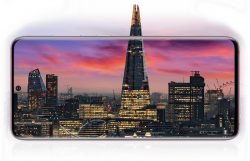 Since the first Galaxy S smartphone was released in 2010, Samsung has consistently pushed the limits on their mobile phone displays. The company was a pioneer of using organic LED (AMOLED) displays on a smartphone. AMOLED offers a richer and more vibrant viewing experience than regular LCD displays used on many other phones. They were also pioneers of curved display technology which was introduced in 2015 on the Galaxy S6.
Since the first Galaxy S smartphone was released in 2010, Samsung has consistently pushed the limits on their mobile phone displays. The company was a pioneer of using organic LED (AMOLED) displays on a smartphone. AMOLED offers a richer and more vibrant viewing experience than regular LCD displays used on many other phones. They were also pioneers of curved display technology which was introduced in 2015 on the Galaxy S6.
This year, the Galaxy S20 phones have Samsung’s most advanced and technologically impressive displays to date.
On all three phones, you’ll have a Quad HD+ screen giving you a resolution of up to 3200×1440 pixels. This gives you a super-sharp viewing experience, with a pixel densities between 511 and 563 pixels per inch. There’s also the ability to use a 120Hz refresh rate for smoother scrolling and higher refresh rates when you’re using apps or playing games on your phone (available when using Full HD+ resolution).
As before, the displays are still using organic LED, but they’ve been upgraded to use Samsung’s latest Dynamic AMOLED technology. According to Samsung, the screen has a contrast ratio of 2,000,000:1 with a peak brightness level of 1200 nits. This should ensure clear viewing outdoors, even in direct sunlight. The screen also has HDR10+ certification which gives you cinema-grade colour and contrast when viewing HDR content. A blue light reduction feature is also built in to reduce eye strain and fatigue.
 All three Galaxy S20 phones use Samsung’s Infinity-O display. What this means is the space on the front of your handset has been engineered to maximise the screen space and to minimize the bezels. You get something that’s pretty close to an edge-to-edge display, with a gentle curve on both edges of the phone for a smooth and sleek look. To enable the Infinity-O layout, Samsung has placed a small cut-out at the top of the screen for the front camera of the phone. The screen also has a built-in ultrasonic fingerprint sensor allowing you to unlock your device quickly and securely.
All three Galaxy S20 phones use Samsung’s Infinity-O display. What this means is the space on the front of your handset has been engineered to maximise the screen space and to minimize the bezels. You get something that’s pretty close to an edge-to-edge display, with a gentle curve on both edges of the phone for a smooth and sleek look. To enable the Infinity-O layout, Samsung has placed a small cut-out at the top of the screen for the front camera of the phone. The screen also has a built-in ultrasonic fingerprint sensor allowing you to unlock your device quickly and securely.
In terms of differences between the handsets, each Galaxy S20 phone has a different sized screen. The Galaxy S20 has the smallest screen at 6.2-inches. This increases to 6.7-inches on the Galaxy S20+ and to 6.9-inches on the Galaxy S20 Ultra.
For more information, DisplayMate has carried out an in-depth test of the display on the Galaxy S20.
Network & Speeds
 In the UK, the regular Galaxy S20 is available in both 4G and 5G versions, whereas the Galaxy S20+ and Galaxy S20 Ultra come in only 5G-ready variants.
In the UK, the regular Galaxy S20 is available in both 4G and 5G versions, whereas the Galaxy S20+ and Galaxy S20 Ultra come in only 5G-ready variants.
There are three key benefits to choosing a 5G-ready version of the Galaxy S20:
- You’ll get access to faster download speeds on 5G. For instance, Vodafone offers average download speeds of 150-200Mbps on their 5G network. This allows you download content like entire albums and TV shows in just a matter of seconds. You can also upload content much faster which is useful for cloud storage and for backing up your photos online.
- You’ll get lower latency on 5G. Latency refers to the amount of time it takes for data to travel from your phone to the internet and back. With 5G technology, you’ll benefit from lower latency which makes everything a bit more responsive online. It’s also important for things like online gaming and augmented reality applications.
- You’ll get access to 5G networks with greater capacity. 5G mobile networks have much more capacity for carrying data than 4G networks. This means you’ll be able to use your phone in busy urban areas like train stations and shopping centres without the network getting congested and slowing down.
Design & Form Factor
 The Galaxy S20 phones are constructed with a solid aluminium frame, with both the front and the back of the device being covered in scratch-proof Gorilla Glass. All three phones are IP68-rated meaning they’re dust-proof and water-proof for up to 30 minutes at a depth of 1.5 metres.
The Galaxy S20 phones are constructed with a solid aluminium frame, with both the front and the back of the device being covered in scratch-proof Gorilla Glass. All three phones are IP68-rated meaning they’re dust-proof and water-proof for up to 30 minutes at a depth of 1.5 metres.
On the front of the phone, you’ll find the Infinity-O display with a gently curving edge-to-edge screen and a small cut-out for the front camera. On the rear of the phone, you’ll find a rectangular module with the camera and on the bottom, you’ll find a USB-C port and speaker.
Notably, Samsung has omitted a 3.5mm headphone socket on this year’s Galaxy S20 devices. You’ll get a pair of USB-C earphones included in the box, or you can use a pair of wireless Bluetooth earphones instead like Samsung’s Galaxy Buds.
In terms of differences between the three devices, the main thing is really the size of the phone. The Galaxy S20 is the most portable of the three devices, weighing 163g and having a 6.2-inch screen. The Galaxy S20+ goes up to 186g with a 6.7-inch screen. Finally, the Galaxy S20 Ultra is the largest of the three, weighing 220g and having a 6.9-inch screen.
The Galaxy S20 is available in Cosmic Grey, Cloud Pink and Cloud Blue. Meanwhile, the Galaxy S20+ and Galaxy S20 Ultra are available in Cosmic Grey and Cosmic Black colours.
Software
 The Samsung Galaxy S20 devices come with the latest version of Google’s Android 10 operating system for mobile phones. This means you’ll have access to all of the latest features from Google including live caption, gesture-based navigation and improved privacy controls. You’ll also get access to all of the normal Google applications including Chrome, Docs, Gmail, Maps and the Google Play Store.
The Samsung Galaxy S20 devices come with the latest version of Google’s Android 10 operating system for mobile phones. This means you’ll have access to all of the latest features from Google including live caption, gesture-based navigation and improved privacy controls. You’ll also get access to all of the normal Google applications including Chrome, Docs, Gmail, Maps and the Google Play Store.
On top of the Android 10 operating system, Samsung offers their One UI 2 interface. This has additional functionality like streamlined notifications, digital wellness and the ability to customise your phone with custom themes.
Technical Specifications
The following table shows a side-by-side comparison of the technical specifications for the Galaxy S20, Galaxy S20+ and Galaxy S20 Ultra:
| Samsung Galaxy S20 | Samsung Galaxy S20+ | Samsung Galaxy S20 Ultra | |
|---|---|---|---|
 |
 |
 |
|
| Display | |||
| Screen Size: | 6.2-inch | 6.7-inch | 6.9-inch |
| Display Type: | Dynamic AMOLED | Dynamic AMOLED | Dynamic AMOLED |
| Resolution: | 3200×1440 (Quad HD+) | 3200×1440 (Quad HD+) | 3200×1440 (Quad HD+) |
| Pixel Density: | 563ppi | 525ppi | 511ppi |
| Refresh Rate: | Up to 120Hz | Up to 120Hz | Up to 120Hz |
| Camera | |||
| Rear Cameras: | 3 cameras with OIS | 4 cameras with OIS | 4 cameras with OIS |
| → Ultra-Wide Camera: | ✔ 12 megapixels | ✔ 12 megapixels | ✔ 12 megapixels |
| → Wide-Angle Camera: | ✔ 12 megapixels | ✔ 12 megapixels | ✔ 108 megapixels |
| → Telephoto Camera: | ✔ 64 megapixels | ✔ 64 megapixels | ✔ 48 megapixels |
| → DepthVision Camera: | ✘ No | ✔ Yes | ✔ Yes |
| Zoom: | 3x Hybrid Optical 30x Super Resolution |
3x Hybrid Optical 30x Super Resolution |
10x Hybrid Optical 100x Super Resolution |
| Video Recording: | 4K@60fps, 8K@24fps | 4K@60fps, 8K@24fps | 4K@60fps, 8K@24fps |
| Front Camera: | 10 megapixels | 10 megapixels | 40 megapixels |
| Internals | |||
| Processor: | 64-bit octa-core processor (Exynos 990) | 64-bit octa-core processor (Exynos 990) | 64-bit octa-core processor (Exynos 990) |
| Storage: | 128GB internal + up to 1TB micro-SD |
128GB internal + up to 1TB micro-SD |
128GB or 512GB internal + up to 1TB micro-SD |
| RAM: | 8GB (4G model) 12GB (5G model) |
12GB | 12GB (128GB model) 16GB (512GB model) |
| Battery: | 4,000mAh | 4,500mAh | 5,000mAh |
| Wi-Fi: | Wi-Fi 6 | Wi-Fi 6 | Wi-Fi 6 |
| Other | |||
| Weight: | 163g | 186g | 220g |
| Dimensions: | 15.2 x 6.9 x 0.79 cm | 16.2 x 7.4 x 0.78 cm | 16.7 x 7.6 x 0.88 cm |
More Information
For more information about the Galaxy S20, please see Samsung’s official website.
Your Comments
We'd love to hear your thoughts and any questions you may have. You can add your own comment here.